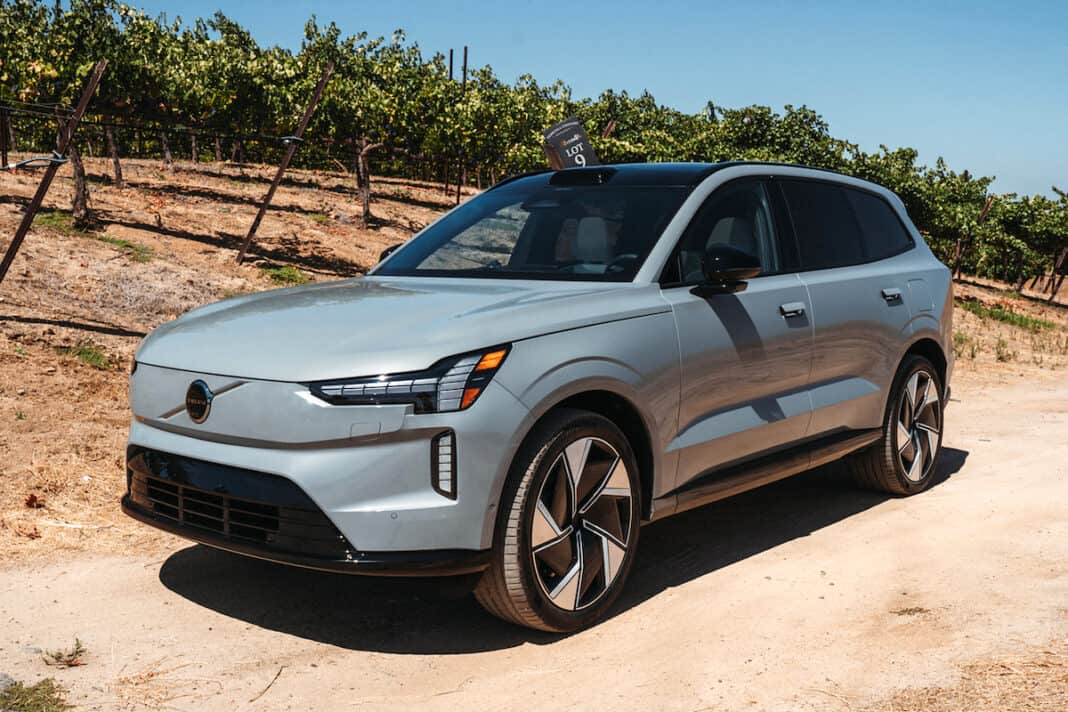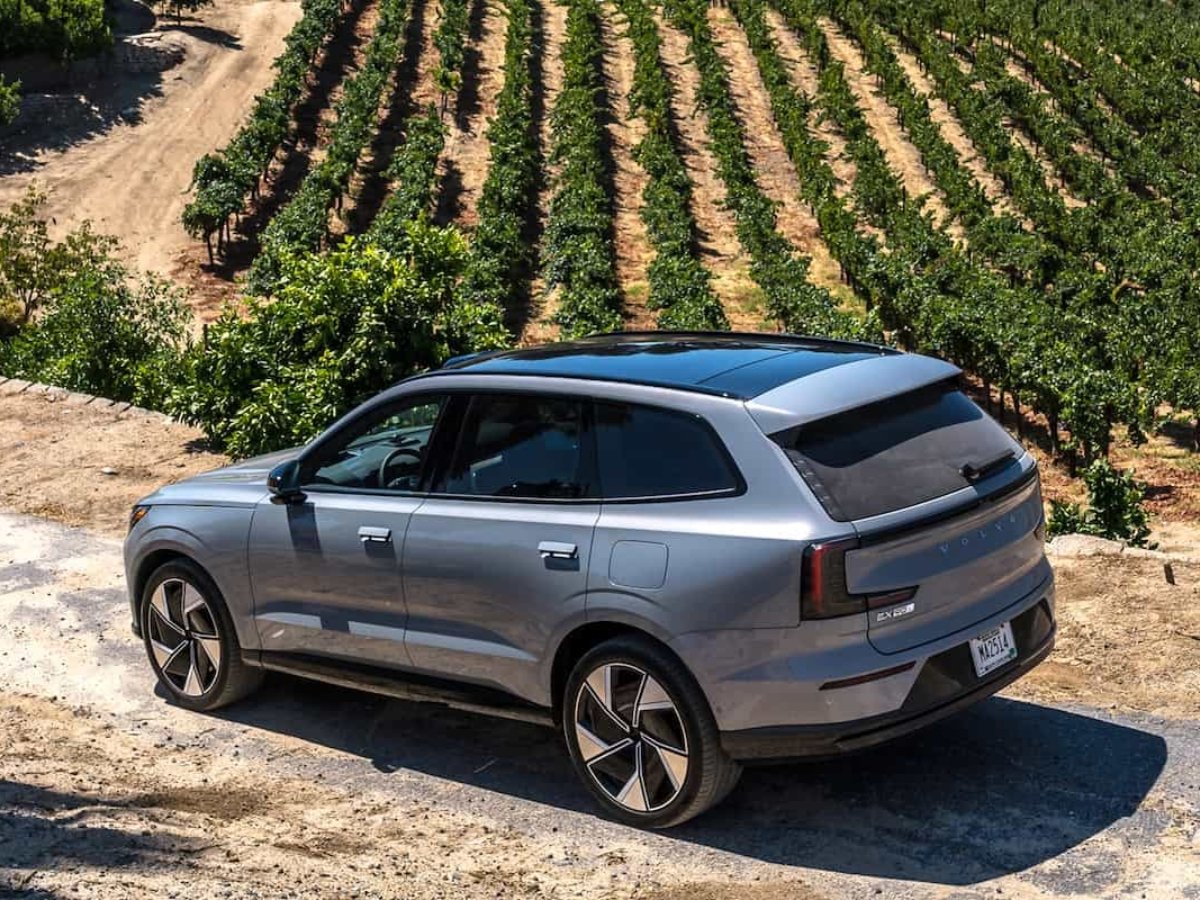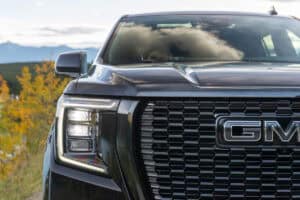Newport Beach, CA – Volvo won’t be retiring the XC90 plug-in hybrid, but its new EX90 all-electric SUV will be the brand’s luxury option going forward. It certainly fits in along the Pacific Coast Highway along California’s affluent enclaves of Newport Beach and Laguna Beach and the canyon roads further inland. Yet there are nuances that make this ride an interesting one — especially if all the future updates come to pass and augment the whole package.
At this point, the EX90 is hardly a mystery since it’s been unveiled, but driving it is another story. The previous EX30 offers some clues because the design principles follow a very similar minimalist path filled with recycled materials and roomy space inside. So roomy, in fact, it’s the brand’s first foray into a three-row vehicle of any kind.
Performance And Driving Impressions: The Volvo EX90’s Twin Motor Experience
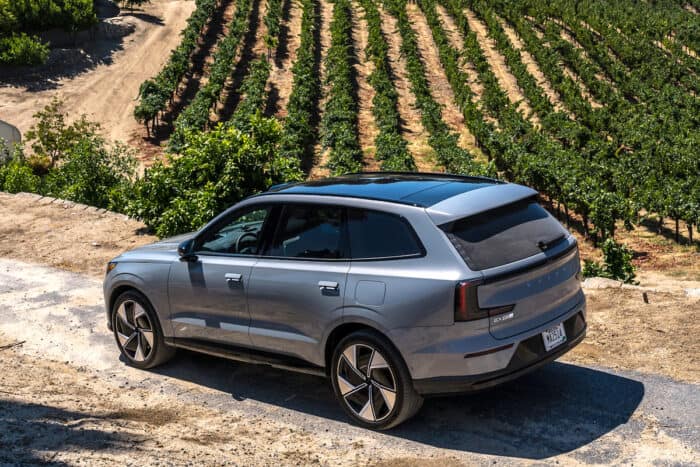
For the most part, the Plus and Ultra trims share many of the same key features. Both use the same Twin Motor platform and battery pack, albeit with slight differences in power and performance. The two powertrain options start with the $81,290 USD ($110,000 CAD) Twin Motor version Plus trim that offers 402 hp and 568 lb-ft of torque, whereas the $86,290 USD ($115,200 CAD) Twin Motor Performance Ultra trim tested in California raises that to 510 hp and 671 lb-ft of torque.
One-pedal driving also feels more natural, especially at faster speeds where any slight variance in pressure from your foot to the pedal doesn’t come with a jolt of regenerative braking.
Despite the differences, the broader all-wheel drive (AWD) architecture is the same, where the rear electric motor harnesses more power, including the ability to disconnect the rear wheels. The Performance variant may not beat other vehicles in a long race, but it posts a respectable 4.9 seconds from 0-100 km/h, which is a solid number for a vehicle weighing in at 3,390 kg (7,473 lbs.)
EX90 range expectations hold up
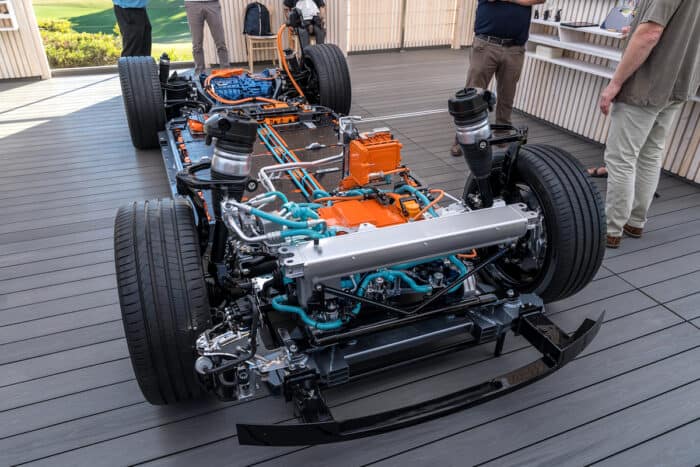
Volvo’s claims about range do seem to hold up after a day’s driving. Both variants have the same 111 kWh capacity (107 kWh is usable), which is good for up to 495 km (roughly 300 miles). It can take 30 minutes to go from 10-80% with a preconditioned battery and DC fast charger that peaks at 250 kW — the EX90’s max charging speed. I never got to test the charging speeds, so can’t be sure how quick and painless that process would be. What’s cool is that setting a charging station as a destination automatically initiates preconditioning so that it’s ready when you plug in.

As for the drive itself, it’s smooth and refined throughout, with nary a jolt or jerk when taking a corner or accelerating to catch up with the flow of traffic. One-pedal driving also feels more natural, especially at faster speeds where any slight variance in pressure from your foot to the pedal doesn’t come with a jolt of regenerative braking.
Manual input required for optimal performance

The EX90 excels more in its acceleration, which is where you feel more of the power compared to its cruising speed, no matter how fast it might go. There are ways to change that, though they require manual input on your end. Since Volvo eschews distinct driving mode presets, you need to go into the driver dynamics settings on the 14.5-inch portrait-oriented screen and turn on both performance mode and set steering and suspension from “soft” to “firm”. There is no way to automate this, and while the vehicle remembers your choices next time you drive, you have to manually change them back when you don’t want them.
Other OEMs routinely offer “Sport” or “Comfort” modes that take the guesswork out of individual settings, so at the very least, Volvo should consider offering the option to save a preset as a workaround.
Volvo’s reasoning is that it offers flexibility for a wider subset of drivers, but it’s hard to understand how such a software-driven platform would be devoid of simple driver settings presets. Other OEMs routinely offer “Sport” or “Comfort” modes that take the guesswork out of individual settings, so at the very least, Volvo should consider offering the option to save a preset as a workaround.

The suspension system is also worth mentioning because it’s one of the biggest differences between the Plus and Ultra trims. On Ultra models, it’s made up of four units with two air chambers in each one, including adaptive dampers that check balance 500 times a second. Drive with “soft” suspension enabled and both chambers use air volume sealed off with a valve. With “firm”, only one chamber activates to give the premium full-size SUV a sturdier feel. The beauty of it is you don’t feel the change kick in like turning on a light. It just works and makes the drive feel sportier.

Pilot Assist, however, is going to need something extra down the line. As is, it feels dated by semi-autonomous driving standards. It does a nice job keeping the EX90 from straying out of a lane, but we won’t know how much better any of the automated driver safety features will be until Volvo releases major software updates in 2025. Those are supposed to bring in the LiDAR sensor mounted on the roof that will enable the SUV to see other vehicles, cyclists, and pedestrians up to 820 feet away anytime, day or night.
Comfort and Calm Inside the Volvo EX90
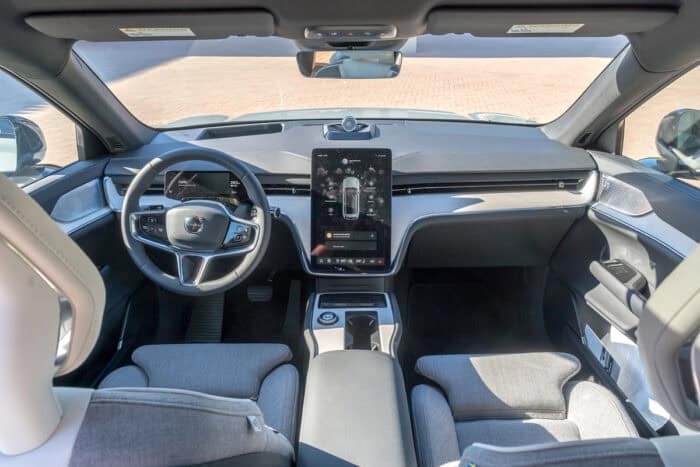
The quiet comfort is all part of the allure here, which is also why the Ultra trim may be the one offering more solitude. I don’t know for sure having never driven the Plus variant, but laminated side and rear windows further dampened outside noise while driving for me. The Plus trim has tempered glass that likely won’t have quite the same effect. Either way, this is one of the quieter drives I can recall, where even a bustling scene in Laguna or a passing transport truck on the I-15 didn’t penetrate the interior cabin in any significant way.

Mind you, it might be them hearing you if you blast tunes through the 25-speaker Bowers & Wilkins sound system. Loud and clear, it’s outstanding audio for any vehicle, especially when you try the 3D surround and concert hall effects, though it’s also exclusive to the Ultra trim. Plus models get a 14-speaker Bose system instead. My one gripe is that there’s a 9-band equalizer and no way to save selections as presets. Once you get the right mix onscreen, you have to keep it that way unless you remember how to set it back again. Given other Bowers & Wilkins headphones and speakers offer custom presets, it’s a perplexing omission here.
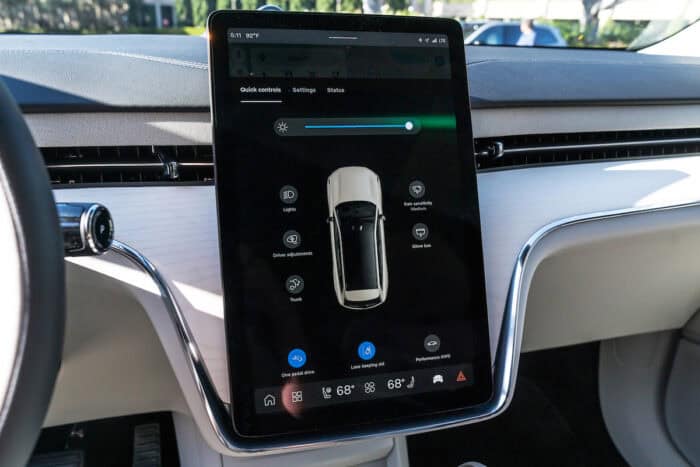
As for the comforts inside, drivers and those riding shotgun will have nothing to complain about. The Ultra trim even throws in massage seats. The middle row should also feel pretty comfortable but it’s that last row in the back that will probably feel the most constrained. The seats sit atop part of the rear motor, elevated further by a ventilation shaft that raises part of the floor, leaving far less leg room. Even though the middle seats can move forward, it doesn’t truly mitigate the problem. Kids probably won’t notice or care about the tighter confines but putting adults back there will likely elicit some laughs or complaints.
Given Volvo is touting the EX90 as a viable six- or seven-seater, that matters. All rear seats can lay flat for extended trunk space, so there is that, but I suspect some will balk at how tight things are in that back row for longer road trips.

Volvo’s choice for wool blend or “Nordico” materials feel fine, and I got to try both during my day of driving the EX90 around, so can’t say there’s an inherent advantage one way or the other. In an age where microplastics are everywhere, I do wonder if materials made from recycled plastics might prove troublesome over time even if there’s an air purifier inside.
The minimalist approach is all over the cabin. Unlike the EX30, this SUV has a digital cluster and HUD in front of the steering wheel, taking some of that contextual driving information (and your gaze) away from the main infotainment screen.
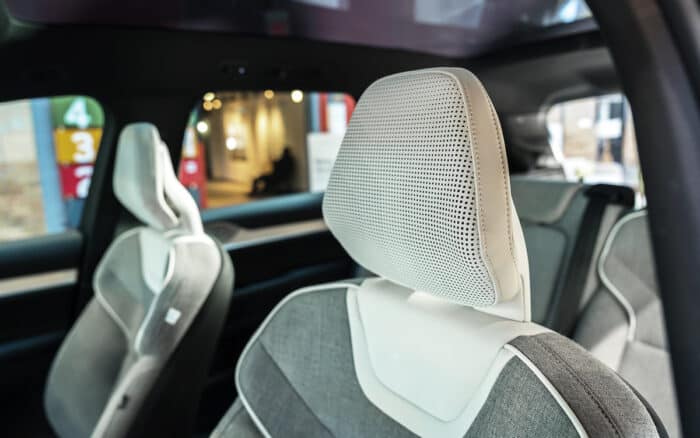
Cup holders appear out of the centre console, with a Qi wireless charging pad in the front. There are four USB-C ports, two in the front, two in the back facing the middle row. Going even further with the minimalism, there is no key or fob, nor even an on/off switch for the vehicle. You get an NFC-equipped card or you can use the ultra-wideband (UWB) technology in your iPhone or Android phone to unlock the SUV by just approaching it. Get in and it should be ready to roll once you put it in drive.
Understated Styling in the EX90’s Design

Depending on the trim, the EX90 can have 20- or 21-inch wheels, with different rims to go with the size you get. The Thor’s Hammer headlights and overall styling appear, at least to my eyes, like a larger sibling to the EX30. Naturally, this larger SUV is longer and taller but the understated design in its exterior gives the EX90 a sleek look.
Volvo prioritizes aerodynamics over a need to look pretty, and it feels that way when driving the EX90. Clean lines and flatter contours cut a slicker figure, as does the lower centre of gravity for something its size.
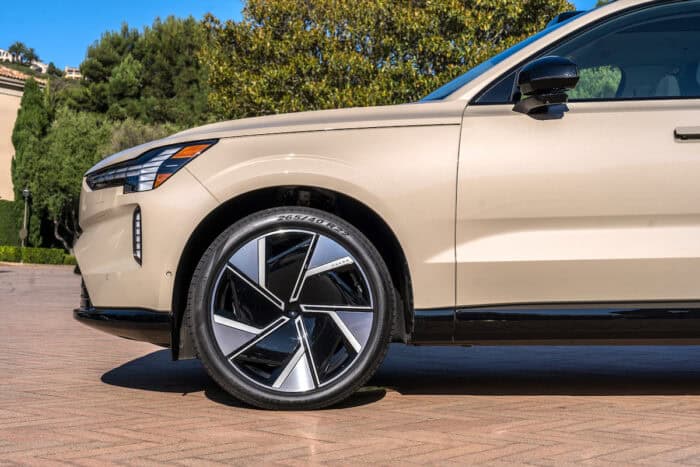
It also doesn’t look overgrown or ostentatious, so while it may cost a lot to get into one, it may not be the head-turning status symbol some other SUVs tend to be (Escalade, Denali, Maserati, etc.) In essence, the EX90 makes a bigger statement inside than it does out. The panoramic roof is a sure crowd-pleaser, and Volvo also offers some accessory upgrades, like mud flaps, running boards and hitch with towball.
Takeaway
Pros:
- Smooth and refined driving experience with excellent acceleration
- Quiet and comfortable cabin with premium sound system options
- Minimalist design with a focus on aerodynamics and sleek styling
Cons:
- Manual adjustments are needed for performance settings without preset driving modes
- Tight third-row seating with limited legroom, especially for adults
- Lack of head-turning exterior design compared to more ostentatious luxury SUVs
As smooth as the overall drive was, the EX90 isn’t without software bugs that need squashing. Volvo clarified beforehand these test drive vehicles were “close to final” so bugaboos were to be expected but the bigger question is over how the major software updates coming in 2025 will add to the overall experience. It’s not unlike how adding a big software feature on an electronics device can impact or enhance its usability.
As is, the EX90 makes a strong case that a full-size SUV can go all-electric and drive impressively well, much like the Kia’s full-size EV9 SUV. The powertrain and suspension system, particularly on the Ultra trim, make the SUV feel like it’s got another trick up its sleeve, even if it won’t necessarily zoom past every other car on the road at its reduced top speed.
At this price range, a $5,000 discrepancy between trims seems almost meaningless for anyone whose budget is well within the luxury category. The Ultra trim offers the trappings of a quieter and more responsive driving experience. Not to mention the upgrade in audio fidelity. Assuming Volvo follows through and hits an entirely different level with its driver safety system with its future updates, then there’s a lot to like about the EX90 in spite of its current drawbacks.

